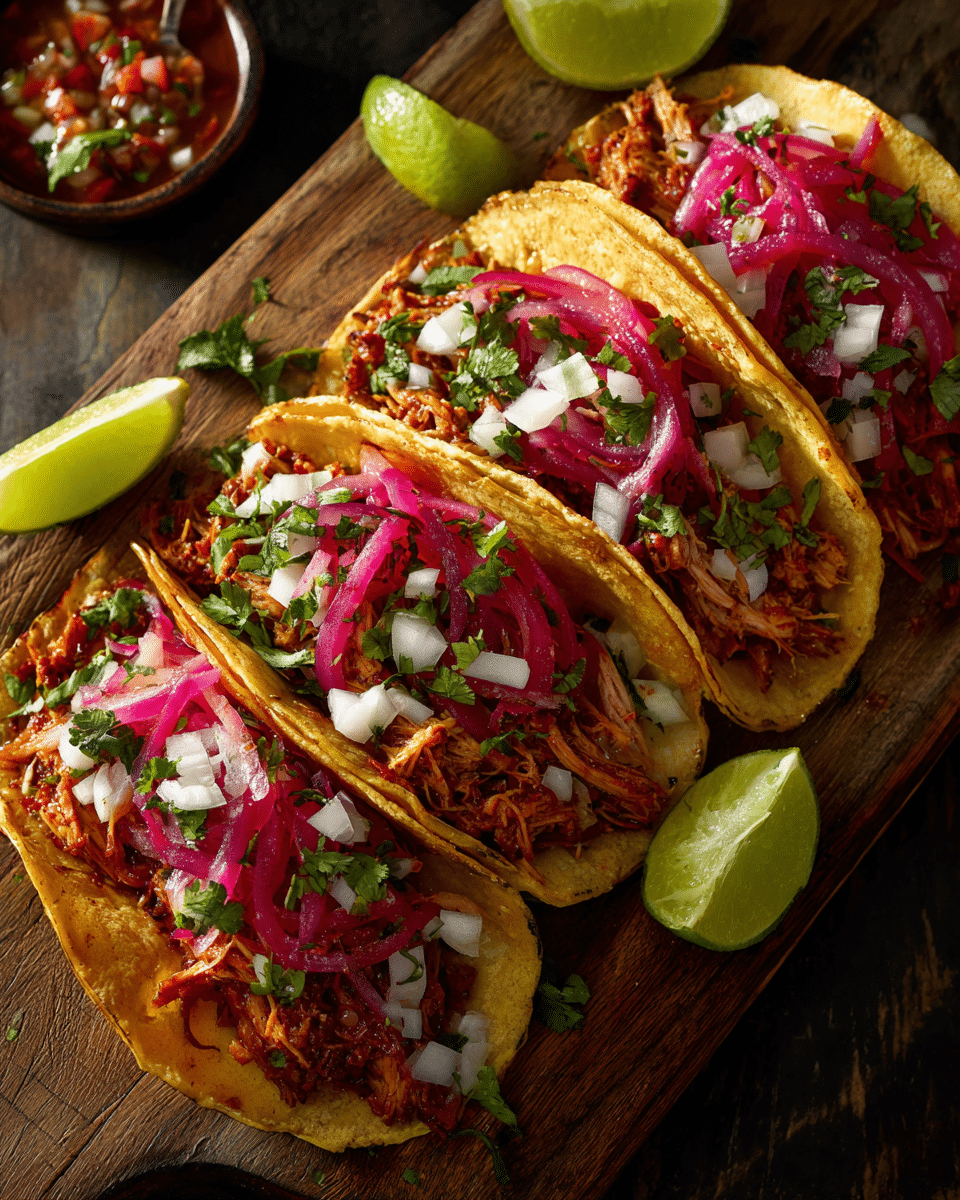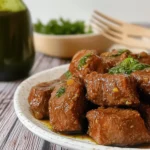Cochinita Pibil is a traditional Yucatán dish known for its vibrant flavors and rich cultural heritage. This slow-cooked pork recipe features a citrus and achiote marinade, resulting in tender, flavorful meat with a signature reddish hue. Traditionally wrapped in banana leaves and cooked low and slow, the dish is now enjoyed in many forms especially as tacos, where juicy pulled pork is served on warm tortillas and topped with tangy pickled onions and fresh herbs.
FULL RECIPE
Ingredients
- 3 lbs pork shoulder, cut into large chunks
- 1/2 cup achiote paste
- 1 cup freshly squeezed orange juice
- 1/4 cup freshly squeezed lime juice
- 6 cloves garlic, minced
- 1 tablespoon ground cumin
- 1 tablespoon dried oregano
- 1 tablespoon salt
- 1 teaspoon ground black pepper
- 1/4 teaspoon ground cinnamon
- 1/4 teaspoon ground cloves
- 3 bay leaves
- Banana leaves (optional) or aluminum foil for wrapping
- 16 small corn tortillas, warmed
- Pickled red onions, for garnish
- Fresh cilantro leaves, for garnish
- Lime wedges, for serving
Directions
- In a large mixing bowl, whisk together achiote paste, orange juice, lime juice, garlic, cumin, oregano, salt, pepper, cinnamon, and cloves until smooth.
- Add pork chunks to the marinade, coating each piece thoroughly. Cover and refrigerate for at least 6 hours, preferably overnight.
- Preheat oven to 325°F (160°C).
- If using banana leaves, pass them briefly over heat to soften. Line a roasting pan with banana leaves or foil.
- Place marinated pork and bay leaves in the lined pan. Pour remaining marinade over the pork. Wrap tightly with banana leaves or foil.
- Cover the pan with a lid or more foil and bake for 3–4 hours, or until pork is fork-tender.
- Remove from oven, shred pork with two forks, and mix with pan juices.
- Serve pork in warm tortillas topped with pickled onions, cilantro, and lime juice.
Nutrition Facts
- Calories: 350
- Protein: 28g
- Total Fat: 18g
- Saturated Fat: 6g
- Cholesterol: 90mg
- Carbohydrates: 19g
- Dietary Fiber: 3g
- Sugars: 3g
- Sodium: 640mg
- Potassium: 540mg
Historical Background of Cochinita Pibil Tacos
Cochinita Pibil has its roots in the Yucatán Peninsula, where it was originally prepared by the ancient Maya using a cooking technique known as pib, meaning an underground pit. Traditionally, the pork was marinated in a mixture of achiote paste and sour orange juice, wrapped in banana leaves, and slow-cooked underground for hours, resulting in a tender, flavorful dish. Over time, the preparation evolved with Spanish influences, introducing new spices and cooking vessels, but the heart of the recipe remained intact. Serving Cochinita Pibil in taco form is a modern adaptation, making it more portable and accessible without losing its rich cultural essence.
Flavor Characteristics and Sensory Experience
The flavor of Cochinita Pibil tacos is a harmonious blend of earthy, tangy, and aromatic notes. The achiote paste provides a peppery, slightly nutty base, while the citrus marinade infuses a refreshing brightness that balances the richness of the pork. Spices such as cinnamon and cloves add warmth and complexity, enhancing the overall depth of flavor. When served as tacos, the combination of juicy pork, tender tortillas, and crisp toppings like pickled onions creates a multi-sensory experience that engages taste, aroma, and texture in every bite.
Nutritional Highlights
Cochinita Pibil tacos, while indulgent, also offer several nutritional benefits. Pork shoulder is a rich source of high-quality protein, which is essential for muscle repair and growth. The citrus components provide vitamin C, which supports immune function and aids in iron absorption. The use of corn tortillas offers a gluten-free carbohydrate source, with dietary fiber that promotes digestive health. Fresh garnishes like cilantro and onions add antioxidants, phytonutrients, and a boost of freshness, making the dish both flavorful and nutritionally balanced when enjoyed in moderation.
Popular Variations and Modern Adaptations
While the traditional recipe uses pork, many variations have emerged to cater to different tastes and dietary preferences. Chicken or turkey can be used as leaner protein options, while jackfruit serves as a popular plant-based substitute due to its ability to mimic shredded pork’s texture. Some cooks add heat by incorporating habanero salsa or chili oil, while others experiment with fusion versions, such as Cochinita Pibil quesadillas, tostadas, or lettuce wraps. These adaptations maintain the signature flavor profile while offering fresh ways to enjoy the dish.
Serving Ideas for Maximum Enjoyment
The best way to enjoy Cochinita Pibil tacos is to serve them fresh and hot, with the pork generously portioned onto warm corn tortillas. Traditional toppings include pickled red onions, fresh cilantro, and lime wedges for an extra burst of brightness. For added crunch and texture, some opt for shredded cabbage or radish slices. Serving them alongside classic Mexican sides like black beans, elote, or arroz rojo elevates the meal into a more complete dining experience. Presenting the toppings buffet-style allows guests to customize their tacos to their liking.
Beverage and Side Pairings
Cochinita Pibil tacos pair wonderfully with drinks that complement their tangy and earthy notes. Refreshing non-alcoholic choices like hibiscus tea (agua de jamaica), horchata, or tamarind agua fresca help balance the richness of the pork. For alcoholic options, light lagers, citrusy pale ales, or smoky mezcals work exceptionally well. Side dishes such as grilled corn, mango salsa, or avocado salad add contrasting flavors and textures, making the meal more dynamic and satisfying.
Cooking Techniques for Best Results
The secret to perfect Cochinita Pibil tacos lies in slow cooking, which allows the flavors of the marinade to fully penetrate the meat. While the traditional method involves an underground pit, modern kitchens can achieve similar results using an oven, slow cooker, or pressure cooker. Wrapping the pork in banana leaves not only imparts a subtle herbal aroma but also locks in moisture for a succulent texture. Shredding the pork and mixing it back into its cooking juices ensures every bite is flavorful and juicy.
Storage and Reheating Guidelines
Cochinita Pibil tacos are excellent for meal prep, as the flavors deepen over time. Store shredded pork in an airtight container in the refrigerator for up to four days or freeze for up to three months. To reheat, gently warm the pork in a skillet over medium heat with a splash of broth or water to prevent drying out. Tortillas should be warmed separately to maintain their texture. Pickled onions, when stored properly in the refrigerator, can last for several weeks, making them a convenient topping for multiple meals.
Health-Conscious Modifications
For a lighter version of Cochinita Pibil tacos, consider using leaner cuts of meat such as pork tenderloin or chicken breast. Reducing the amount of added salt and opting for whole-grain or lettuce wraps instead of traditional tortillas can lower sodium and carbohydrate intake. Incorporating more fresh vegetables as toppings increases fiber and nutrient density. For plant-based diets, marinated jackfruit or shredded oyster mushrooms can replicate the dish’s signature texture while keeping it entirely vegan.
Advertisement
Why These Tacos Are a Crowd Favorite
Cochinita Pibil tacos stand out because of their distinctive flavor combination and cultural authenticity. Unlike many other taco varieties, they feature a bold balance of earthy achiote, zesty citrus, and aromatic spices that make them memorable after the first bite. Their versatility allows them to fit into casual meals, festive gatherings, or gourmet presentations. Whether served traditionally or with a creative twist, they have an undeniable ability to bring people together over a shared appreciation for vibrant, well-balanced food.
Conclusion
Cochinita Pibil tacos are more than just a meal—they’re a celebration of history, flavor, and versatility. Rooted in ancient Mayan cooking traditions yet adaptable to modern tastes, they offer a unique blend of tangy, earthy, and aromatic elements that appeal to a wide range of palates. With endless customization possibilities, perfect beverage pairings, and practical storage options, they’re as suitable for a weeknight dinner as they are for a festive gathering.






